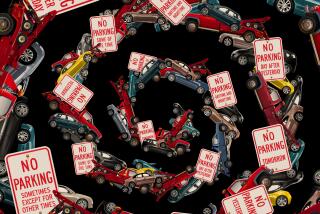Parking Meter Thefts Surge in L.A. : Crime: Losses exceed $500,000 in the last 16 months. City considers resorting to no-parking zones in hard-hit areas such as Downtown and MacArthur Park.
Parking meter thefts have reached epidemic proportions in Los Angeles’ most densely populated areas, with more than $500,000 worth of meters stolen or destroyed by vandals during the past 16 months, according to transportation officials.
The vandals, generally transients and drug addicts desperate for the coins in the meters, smashed 1,675 city meters in the 12-month period ending in April, costing the city about $437,000. Officials said the total now approaches 2,200 meters. The financial losses include damage to equipment and theft of meter money but exclude the costs of labor to replace the meters.
“This is the worst situation that we’ve run into in terms of meter thefts, there’s no question about that,” said Jack Reynolds, senior engineer for the Department of Transportation, who has worked for the city for 30 years. “We have a more desperate population out there in the way of homeless people than we used to have.”
Since April, 1993, the combined efforts of the Police Department and a five-person task force from the transportation department have failed to curb the number of thefts. The Westlake area surrounding MacArthur Park has taken the brunt of the meter mayhem, with more than $200,000 in equipment and revenue lost in 936 meter thefts during the 12-month period. Other hard-hit areas are the Downtown business district and the Civic Center, said Deborah Brown, chief investigator for the transportation department.
The situation has grown so aggravated that officials are considering eliminating parking meters altogether in the affected areas and replacing them with red zones, where no parking would be permitted. “The last resort would be no parking. We would red-zone everything,” Brown said. Drivers would have to park in designated parking structures or lots some distance from the area, she said.
Before 1993, meter thefts were a minor problem, Brown said. But they have mushroomed in the past 16 months. “It was a rash and it spread like a wildfire,” she said.
The parking meters, which cost $261 each, are usually destroyed when they are knocked off their poles and smashed open by vandals using water meter covers, manhole covers or large pieces of concrete, Reynolds said. Sometimes the entire meter head and pole are pulled out of the ground by vandals who soak the surrounding dirt and loosen the meter pole, said Lee Prentiss, a burglary detective in the Los Angeles Police Department’s Rampart Division.
Although police say that many of the vandals are repeat offenders, there is no evidence that any particular group is behind the citywide thefts. If caught, suspects could face charges ranging from receiving stolen goods to grand theft. Depending on the culprit’s record, either misdemeanor or felony charges could be brought.
After breaking off the 10- to 15-pound meter heads, the vandals usually transport them in shopping carts and dump them in what officials call “graveyards”--vacant lots two or three blocks from the meter’s original location. Last week the task force found 112 meters in an empty lot at 1st Street and Beaudry Avenue.
Often, when the city replaces a meter, it is “guaranteed to be gone” within four days, said Brown.
“(The epidemic) is a sign of the times. The economics are bad, there are homeless people without incomes . . . it all adds up on our little meters. They (the vandals) indiscriminately choose the meters. They don’t care if it has a dime or $100, it is a source of revenue for them,” she said.
The problem of meter thefts has not struck other major cities such as San Diego, San Francisco and Phoenix, each of which report far fewer thefts and sometimes almost no parking meter vandalism.
San Diego, which has 5,300 meters, had only one parking meter theft last year, according to the city’s parking meter supervisor. Phoenix reported six meter thefts in 1993. San Francisco officials said parking meter thefts have not been a major problem, though a rash of them occurred earlier in the summer.
Reynolds attributes the higher number of thefts in Los Angeles to the greater number of meters--41,000 citywide--and a larger homeless population. “What we are looking at is someone who is desperate or determined to get the money, and once they figure out how to do it they continue to do so,” he said.
The task force, working with the Rampart and Central police stations, has brainstormed ideas on dealing with the thefts.
Among the possibilities are more secure meters, which are being tested near MacArthur Park, and coinless meters--in which motorists prepay using a “smart card,” similar to a credit card, or a cylindrical key--which have been installed on one Westwood block.
Ultimately, officials said they have to evaluate whether the revenue generated by the meters makes it worthwhile to keep replacing them. “We have to measure how much it is costing the city to combat these crimes as opposed to how much we are earning from the parking meters,” Brown said.
More to Read
Sign up for Essential California
The most important California stories and recommendations in your inbox every morning.
You may occasionally receive promotional content from the Los Angeles Times.









